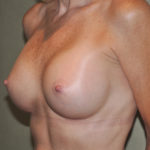
Rippling occurs as a result of the physical interface between the saline and the elastic silicone polymer shell . The exact reason wrinkling of the breast implant occurs has to do with how well the filler material coats the inside of the implant and bonds to it as well as its own viscosity. Water (or saltwater) flows easily and does not ’stick’ well to the inside wall of the breast implant shell, resulting in implant buckling and folding. This is a normal finding with saline breast implants and its presence is not abnormal or the plastic surgeon’s fault. Placement of saline breast implants above the muscle is also much more likely to lead to visible implant wrinkling in thin individuals as there is little breast tissue to cover the visible ripples and there is no pressure on the implant from the overlying muscle. Textured saline implants are particularly prone to rippling due to their thicker shell (harder for the water to push it out) and due to traction from the implant grabbing the thicker non-stretchable surrounding scar that it creates. The combination of textured saline breast implants above the muscle has the highest incidence of significant wrinkling issues.
Established ways to diminish the amount of wrinkling which can occur are to overfill the breast implant with more saline than the implant base size (increase the internal fluid pressure) and to place the saline breast implants under the muscle. (which puts more pressure on the outside of the implant). Both of these methods do lead to less wrinkling, but neither can completely prevent it. Overfilling a breast implant with too much saline will make it feel more firm than normal breast tissue, although this is generally well accepted by most patients. The best approach for prevention is to use non-textured saline implants placed under the muscle which are then filled 25 to 50cc more than its base size. While all implant wrinkling can not be prevented with saline fills, a significant reduction can be seen in most patients with this approach.
Dr. Barry Eppley
Indianapolis, Indiana



